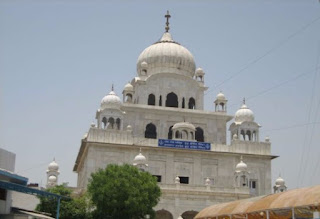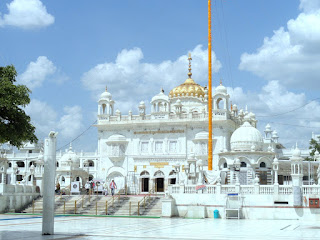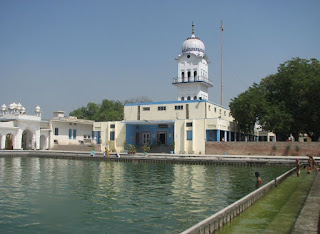Gurdwara Majnu ka Tilla
Gurdwara Majnu-ka-Tilla is situated on the right bank of river Yamuna, opposite Timarpur Colony beyond the Khyber Pass section of Delhi, India. The birthday of the Khalsa is celebrated here with much festivity on Baisakhi day. On this day, which holds a special place in the hearts of all Sikhs, the city swells with pilgrims from the surrounding areas. With many people of different creeds, castes, and status join the Sikhs of Delhi. During the festivities a special langar (a free kitchen or meal) of enormous size is arranged.
It is believed that a muslim hermit named Iranian Sufi Abdulla lived here during the rule of Sultan Sikander Shah lodi (1849-1517). He would help people to cross the Yamuna River with his boat and would not charge anything for this service. An unusual story surrounds this gurdwara. For one, it is steeped in history, the spot having been first consecrated in 1505 at the time of Badshah Sikander Lodi. For another, it stands on the banks of the Yamuna, on a height, commanding a view of the river.
Guru Nanak, while visiting Delhi, met the resident Iranian Sufi bhakt, Abdulla, who lived atop this little mound, on the river's bank. The hermit was reed-thin, spending all his waking moments fasting and looking for the true meaning of God — in vain. He would ferry people across the river in his boat — for free — as service to God. People called him Majnu, so lost was he in love and devotion for God.
Abdulla's quest for enlightenment and for the true meaning of God, made him vow to meet Baba Nanak when he heard that the great Guru was in the vicinity. He finally did meet him on July 20, 1505.
This fact is intrinsically woven with another tale at this sacred spot. While the Guru was sitting with his new bhakt, there was the sound of a mahout crying aloud at the loss of the Badshah's elephant under his care. Moved by the sound of his piteous crying, the Guru brought the animal back to life, much to everyone's amazement.
The Guru stayed at the spot till the end of July. So pleased was he with the mad, selfless devotion to God by the Sufi hermit — who people said behaved much like the proverbial love-forsaken Majnu — that Nanak told him this area would be immortalized by his name — as Majnu Ka Tilla or the hillock of Majnu — till the world ended. Later, the small gurdwara that was built there by General Baghel Singh in 1783 was known by this name.
And that's how the name and the gurdwara came about — a Sikh shrine named after a devout Iranian Sufi believer. It stands tall now as an amalgamation of faith, and of the ultimate belief in Ek Onkar, that whatever faith you might believe in, the Ultimate God is One.
The gurdwara has vast grounds and a sarai, where tired travellers driving up or down the Grand Trunk Road (now National Highway No 1) can stay. It has a kitchen that serves free langar to anyone who stops by. We also trooped into the langar mess, and partook of a humble meal of puri, channa-aloo and apple that they served for breakfast that day.
The jagir, or estate, that surrounds it was a gift from Maharaja Ranjit Singh, and the birthday of the Khalsa is celebrated here with much festivity on Baisaki day. A huge sangat gathers here for the day's kirtan, path, and ardas and for participating in the community kitchen that marks Baisakhi. Puran Mashi is also celebrated here enthusiastically.
Says Granthi Bhai Jaswinder Singh, who lives in the complex, "You can also burn your old, tattered religious texts and holy books at the chimney that forms part of the gurdwara complex." He adds that people of all religions bring their disused and tattered holy books to be given a final farewell here.
Long after Guru Nanak met Majnu, the sixth Sikh guru, Guru Har Gobind also stayed here, when he visited Delhi on an invitation from Emperor Jahangir. But the emperor was suspicious of the Guru and had him deported to Gwalior and imprisoned there. Later Guru Har Gobind was released, and on his way back to Punjab, Guruji again stayed at Majnu Ka Tilla.
The marble gurdwara that now stands at this spot was built here in the early '80s, although the small one that has existed over centuries still stands within the complex. The first gurdwara was built by Baghel Singh, when he and 40,000 troops entered the Red Fort in March 1783, and occupied the Diwan-e-am. The Mughal emperor Shah Alam II made a settlement with Baghel Singh, allowing him to raise gurdwaras on Sikh historical sites in the city as well as receive six annas in a rupee (37.5 per cent) of all the octroi duties in the capital. The general camped in the nearby Subzi Mandi with his troops and identified seven sites connected to the Sikh Gurus and had shrines raised on them within eight months. The credit of building the capital's famous Sikh shrines, thus goes to Baghel Singh.
Years later, after the torture and death of his father, when Guru Hargobind was 'invited' to Delhi by Emperor Jahangir, he stayed at Gurdwara Majnu-Ka-Tilla. During his stay he became friends with the Emperor. Later he joined the Emperor's shikars (hunts) and even saved Jahangir from a tiger's attack. When an influential friend of the gravely ill Emperor had the Court Astrologers to suggest to the Emperor to ask his new friend to go to Gwalior Fort to pray for his recovery, Guru Hargobind gladly agreed. When he was released and asked to return to Delhi, Guru ji refused to leave the fort insisting that 52 Hindu prisoners also be set free. Today the event is celebrated as Bandi Chhor Divas. Leaving Delhi, on his way back to the Punjab, Guru ji again visited the hilltop, Majnu-Ka-Tilla, where his fifth predeccesor had stopped to bless Majnu the 'crazy' Sufi who had yearned for, the seemingly unattainable, love of the Kartar (God).
Guru Hargobind's dynamic personality filled the Sikhs with a revolutionary spirit turning them into saviours of dharma and righteousness. He emboldened his followers morally, mentally, and physically to fight the evil designs of the Mughal rulers who were seeking to annihilate the rich cultural heritage of India. With his two swords of 'Miri and Piri' (spiritual and temporal power), a combination of Bhakii and Shakti, Guru Hargobind created warrior saints, to fight against tyranny and oppression. Guru Hargobind's ideology shattered the designs of the ferengi (foreign) rulers and helped to change the course of India's history from slavery to self respect and dignity. Having militarised the Sikhs Guru Hargobind laid the foundation of the Akal Takht just opposite the Harmandir Sahib. It is from the Akal Takht that all the hukamnamas, (religious decrees) are issued to the Sikhs. These decrees are binding on all members of the Sikh community. The Akal Takht has served as a unifying force and a rallying centre for Sikhs during their history's turbulent times.
When Guru Har Rai the seventh Guru sent his son Ram Rai to explain the tenets of Sikhism to Emperor Aurangzeb, he also stayed at Majnu-Ka-Tilla. Thus the Gurdwara here acquired historic importance. There is a well in the compound of this holy shrine. It is said that Ram Rai showed his miracles to Aurangzeb near this well.
Getting there
The Majnu Ka Tilla Gurdwara is in north Delhi, just beyond the inter-state bus terminus, and opposite Timarpur colony on the Yamuna's bank. The Tibetan refugee camp is also close by
For the outbound road traveler on the GT Road, this is a regular stop.
It is believed that a muslim hermit named Iranian Sufi Abdulla lived here during the rule of Sultan Sikander Shah lodi (1849-1517). He would help people to cross the Yamuna River with his boat and would not charge anything for this service. An unusual story surrounds this gurdwara. For one, it is steeped in history, the spot having been first consecrated in 1505 at the time of Badshah Sikander Lodi. For another, it stands on the banks of the Yamuna, on a height, commanding a view of the river.
Guru Nanak, while visiting Delhi, met the resident Iranian Sufi bhakt, Abdulla, who lived atop this little mound, on the river's bank. The hermit was reed-thin, spending all his waking moments fasting and looking for the true meaning of God — in vain. He would ferry people across the river in his boat — for free — as service to God. People called him Majnu, so lost was he in love and devotion for God.
Abdulla's quest for enlightenment and for the true meaning of God, made him vow to meet Baba Nanak when he heard that the great Guru was in the vicinity. He finally did meet him on July 20, 1505.
This fact is intrinsically woven with another tale at this sacred spot. While the Guru was sitting with his new bhakt, there was the sound of a mahout crying aloud at the loss of the Badshah's elephant under his care. Moved by the sound of his piteous crying, the Guru brought the animal back to life, much to everyone's amazement.
The Guru stayed at the spot till the end of July. So pleased was he with the mad, selfless devotion to God by the Sufi hermit — who people said behaved much like the proverbial love-forsaken Majnu — that Nanak told him this area would be immortalized by his name — as Majnu Ka Tilla or the hillock of Majnu — till the world ended. Later, the small gurdwara that was built there by General Baghel Singh in 1783 was known by this name.
And that's how the name and the gurdwara came about — a Sikh shrine named after a devout Iranian Sufi believer. It stands tall now as an amalgamation of faith, and of the ultimate belief in Ek Onkar, that whatever faith you might believe in, the Ultimate God is One.
The gurdwara has vast grounds and a sarai, where tired travellers driving up or down the Grand Trunk Road (now National Highway No 1) can stay. It has a kitchen that serves free langar to anyone who stops by. We also trooped into the langar mess, and partook of a humble meal of puri, channa-aloo and apple that they served for breakfast that day.
The jagir, or estate, that surrounds it was a gift from Maharaja Ranjit Singh, and the birthday of the Khalsa is celebrated here with much festivity on Baisaki day. A huge sangat gathers here for the day's kirtan, path, and ardas and for participating in the community kitchen that marks Baisakhi. Puran Mashi is also celebrated here enthusiastically.
Says Granthi Bhai Jaswinder Singh, who lives in the complex, "You can also burn your old, tattered religious texts and holy books at the chimney that forms part of the gurdwara complex." He adds that people of all religions bring their disused and tattered holy books to be given a final farewell here.
Long after Guru Nanak met Majnu, the sixth Sikh guru, Guru Har Gobind also stayed here, when he visited Delhi on an invitation from Emperor Jahangir. But the emperor was suspicious of the Guru and had him deported to Gwalior and imprisoned there. Later Guru Har Gobind was released, and on his way back to Punjab, Guruji again stayed at Majnu Ka Tilla.
The marble gurdwara that now stands at this spot was built here in the early '80s, although the small one that has existed over centuries still stands within the complex. The first gurdwara was built by Baghel Singh, when he and 40,000 troops entered the Red Fort in March 1783, and occupied the Diwan-e-am. The Mughal emperor Shah Alam II made a settlement with Baghel Singh, allowing him to raise gurdwaras on Sikh historical sites in the city as well as receive six annas in a rupee (37.5 per cent) of all the octroi duties in the capital. The general camped in the nearby Subzi Mandi with his troops and identified seven sites connected to the Sikh Gurus and had shrines raised on them within eight months. The credit of building the capital's famous Sikh shrines, thus goes to Baghel Singh.
Years later, after the torture and death of his father, when Guru Hargobind was 'invited' to Delhi by Emperor Jahangir, he stayed at Gurdwara Majnu-Ka-Tilla. During his stay he became friends with the Emperor. Later he joined the Emperor's shikars (hunts) and even saved Jahangir from a tiger's attack. When an influential friend of the gravely ill Emperor had the Court Astrologers to suggest to the Emperor to ask his new friend to go to Gwalior Fort to pray for his recovery, Guru Hargobind gladly agreed. When he was released and asked to return to Delhi, Guru ji refused to leave the fort insisting that 52 Hindu prisoners also be set free. Today the event is celebrated as Bandi Chhor Divas. Leaving Delhi, on his way back to the Punjab, Guru ji again visited the hilltop, Majnu-Ka-Tilla, where his fifth predeccesor had stopped to bless Majnu the 'crazy' Sufi who had yearned for, the seemingly unattainable, love of the Kartar (God).
Guru Hargobind's dynamic personality filled the Sikhs with a revolutionary spirit turning them into saviours of dharma and righteousness. He emboldened his followers morally, mentally, and physically to fight the evil designs of the Mughal rulers who were seeking to annihilate the rich cultural heritage of India. With his two swords of 'Miri and Piri' (spiritual and temporal power), a combination of Bhakii and Shakti, Guru Hargobind created warrior saints, to fight against tyranny and oppression. Guru Hargobind's ideology shattered the designs of the ferengi (foreign) rulers and helped to change the course of India's history from slavery to self respect and dignity. Having militarised the Sikhs Guru Hargobind laid the foundation of the Akal Takht just opposite the Harmandir Sahib. It is from the Akal Takht that all the hukamnamas, (religious decrees) are issued to the Sikhs. These decrees are binding on all members of the Sikh community. The Akal Takht has served as a unifying force and a rallying centre for Sikhs during their history's turbulent times.
When Guru Har Rai the seventh Guru sent his son Ram Rai to explain the tenets of Sikhism to Emperor Aurangzeb, he also stayed at Majnu-Ka-Tilla. Thus the Gurdwara here acquired historic importance. There is a well in the compound of this holy shrine. It is said that Ram Rai showed his miracles to Aurangzeb near this well.
Getting there
The Majnu Ka Tilla Gurdwara is in north Delhi, just beyond the inter-state bus terminus, and opposite Timarpur colony on the Yamuna's bank. The Tibetan refugee camp is also close by
For the outbound road traveler on the GT Road, this is a regular stop.







Comments
Post a Comment